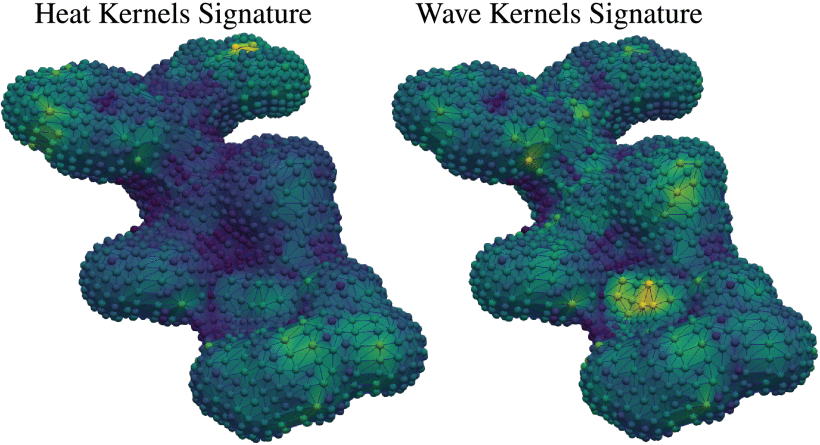Flattening shapes without distortion is a problem that has been intriguing scientists for centuries. It is a fundamental problem of high importance in computer vision as many approaches may greatly benefit from its implementation. This paper introduces a new approach that allows flattening without distortion, by transforming the shape from Riemannian geometry to Weitzenböck geometry. This transformation is obtained by calculating the Cholesky frame associated with the Riemannian metric. In the Weitzenböck space, the Riemann tensor is identically zero which means that the Weitzenböck space is entirely flat. The teleparallel equation, which determines distances in the Weitzenböck space, and the geodesic equation, which determines distances in its Riemannian counterpart, are equivalent. The end result is that there is no distortion when passing from Riemannian geometry to Weitzenböck geometry. Given the importance of the heat kernel in computer vision, analytic solution of the heat kernel in Weitzenböck space is presented.
Displays; doi: 10.1016/j.displa.2022.102323
MODELING OF NON-NEWTONIAN FLOW IN AN INVERTED CONE FOAM BREAKER
G. St-Pierre Lemieux, E. Askari Mahvelatti, D. Groleau and P. Proulx
Foam formation is a widespread phenomenon and often a serious problem in fermentation processes. Inverted cones used as mechanical foam breakers are rotating devices that pump the fluid up and pulverize it at the edge. The shearing and centrifugal actions of such geometries can help to control foaming. In this study, a model was developed using Computational Fluid Dynamics (CFD), based on the non-Newtonian properties of foam, to describe and explain the action of inverted cones as foam breakers.
International Journal of Chemical Reactor Engineering; doi:10.1515/ijcre-2019-0135
INTRODUCTION ON FOAM AND ITS IMPACT IN BIOREACTORS
G. St-Pierre Lemieux, D. Groleau and P. Proulx
Foam formation in bioreactors (fermenters) and other types of reactors is a highly interesting topic that touches several disciplines. All of the phenomena involved in foam formation have been the subject of many studies, but their relationships are still not obvious to newcomers. This review aimed to give the reader a good background for understanding the various phenomena involved in foam formation, especially in bioreactors. Hopefully, this would give the reader the tools necessary to access any needed information about foaming, a task that can be difficult without such basic knowledge.
Canadian Journal of Biotechnology ; doi:10.24870/cjb.2019-000131
SUPERMARINE: GEOMETRY GENERATOR FOR BLOCKMESH
G. St-Pierre Lemieux and P. Proulx
SuperMarine is a geometry generator for OpenFOAM that can be used for stirred tanks commonly used in chemical and biochemical engineering. It aims to give an easy solution for academic research and students that which to use OpenFOAM on common and simple geometry. The scripts create a blockMesh file ready to be used within a OpenFOAM case. SuperMarine was first developed to build a marine impeller, but can also be used to create a wide variety of impeller. The present version of the code is sufficient to create accurately a basic stirred tank design with its impeller, but can be tweaked in order to have more sophisticated shapes. Since it is a python script, the user can change the code has he wish and adapt it to his case.
APPLICATION OF EXTENDED QUADRATURE METHOD OF MOMENTS FOR SIMULATION OF BUBBLY FLOW AND MASS TRANSFER IN GAS-LIQUID STIRRED TANKS
E. Askari Mahvelati, G. St-Pierre Lemieux, P. Proulx
In the present paper, two gas‐liquid stirred tanks, one agitated by a radial impeller and another by an axial impeller, are modelled using the open‐source computational fluid dynamic (CFD) package OpenFOAM (open source field operation and manipulation). The combined effect of the bubble break‐ up and coalescence in the tank is considered by a population balance model (PBM) called extended quadrature method of moments (EQMOM). The three‐dimensional simulation is made using a multiple reference frame (MRF), a well‐established method for the modelling of mixers. Dispersed gas and bubble dynamics in the turbulent flow are modelled using the Eulerian‐Eulerian approach (E‐E) with mixture k‐epsilon turbulent model and the modified Tomiyama drag coefficient for the momentum exchange. The model is developed to predict the spatial distribution of gas phase fraction, Sauter mean bubble diameter (d32), number density function (NDF), dissolved oxygen (DO) evolution, and flow structure. The numerical results are compared with experimental data and a fair agreement is achieved. The results of the axial impeller are discussed based on four impeller rotational speeds with different volumetric mass transfer coefficients.
The Canadian Journal of Chemical Engineering 2019; doi:10.1002/cjce.23470
SIMULATION OF BUBBLY FLOW AND MASS TRANSFER IN A TURBULENT GAS-LIQUID STIRRED TANK WITH CFD-PBM SOLVER IN OPENFOAM: EQMOM APPLICATION
E. Askari Mahvelati, G. St-Pierre Lemieux, C. Braga Vieira, G. Litrico and P.Proulx
In the present paper, the oxygen dispersion in a laboratory scale (3 litres) bioreactor is modelled using open source Computational Fluid Dynamic (CFD) package OpenFOAM (Open Source Operation and Manipulation). The combined effect of the bubble breakup and coalescence in the tank is accounted by a novel method of Population Balance Model (PBM) called Extended Quadrature Method of Moments (EQMOM). The three dimensional simulation is made within a Multiple Reference Frame (MRF), which is a well established method for the modelling of mixers. Dispersed gas and bubbles dynamics in the turbulent flow are modelled using Eulerian-Eulerian (E-E) approach with mixture k-turbulent model. A modified Tomiyama drag coefficient was used for the momentum exchange, as well. Parallel computing is employed to make efficient use of computational power to predict the spatial distribution of gas phase fraction, Sauter mean bubble diameter (d32), Number Density Function (NDF), oxygen mass fraction in water and flow structure. The numerical results are compared with experimental data, and good agreement is achieved.









